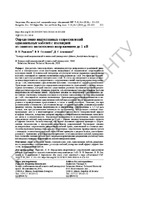| dc.contributor.author | Радкевич, В. Н. | |
| dc.contributor.author | Сталович, В. В. | |
| dc.contributor.author | Алехнович, Д. С. | |
| dc.coverage.spatial | Минск | ru |
| dc.date.accessioned | 2018-07-24T10:14:10Z | |
| dc.date.available | 2018-07-24T10:14:10Z | |
| dc.date.issued | 2018 | |
| dc.identifier.citation | Радкевич, В. Н. Определение индуктивных сопротивлений одножильных кабелей с изоляцией из сшитого полиэтилена напряжением до 1 кВ = Towards Determination of Inductive Resistances of Single-Core Cables with Voltage of up to 1 kV Insulated by Cross-Linked Polyethylene / В. Н. Радкевич, В. В. Сталович, Д. С. Алехнович // Энергетика. Известия высших учебных заведений и энергетических объединений СНГ. - 2018. - № 4. - С. 321-333. | ru |
| dc.identifier.uri | https://rep.bntu.by/handle/data/45299 | |
| dc.description.abstract | Для расчета токов короткого замыкания, потерь напряжения и реактивной мощности в электрических сетях необходима информация об индуктивных сопротивлениях кабельных линий. В технической литературе отсутствуют точные параметры одножильных кабелей с изоляцией из сшитого полиэтилена напряжением до 1 кВ. Это приводит к неточностям в расчетах режимов электрических сетей. В статье рассматриваются вопросы определения индуктивности и индуктивного сопротивления линий электропередачи напряжением до 1 кВ, выполненных одножильными кабелями с изоляцией из сшитого полиэтилена. Произведен анализ формул для определения индуктивности, приводимых в разных литературных источниках, который показал существенное различие численных значений получаемых результатов расчета. Выявлена формула, обеспечивающая более достоверные расчеты индуктивности кабельных линий. Определено влияние на индуктивное сопротивление допустимого увеличения толщины изоляции и оболочки одножильного кабеля напряжением до 1 кВ с изоляцией из сшитого полиэтилена. Произведены расчеты индуктивности и индуктивного сопротивления одножильных кабелей при раскладке их по вершинам равностороннего и прямоугольного треугольников, а также в одной плоскости. Показано, что при расположении в плоскости с расстоянием между соседними кабелями, равным наружному диаметру кабеля, удельные индуктивности и индуктивные сопротивления в 1,7–1,8 раза больше, чем при расположении вплотную по треугольнику. При больших сечениях токопроводящих жил и в многоамперных установках имеют место поверхностный эффект и эффект близости, вследствие которых снижаются напряженность магнитного поля внутри жилы и ее индуктивность. Определены индуктивности и индуктивные сопротивления одножильных кабелей напряжением до 1 кВ с учетом влияния поверхностного эффекта и эффекта близости. Расчеты показали, что неучет указанных эффектов приводит к существенным погрешностям в определении индуктивных сопротивлений. Рассмотрено влияние на индуктивные сопротивления одножильных кабелей брони, выполненной из стальных лент. На иллюстративном примере показано, что индуктивное сопротивление бронированного кабеля с площадью сечения токопроводящей жилы 800 мм² примерно в два раза больше, чем небронированного. Применение в трехфазных электрических сетях одножильных кабелей, бронированных стальными лентами, должно быть запрещено нормативными документами, поскольку такие кабели резко ухудшают эффективность систем электроснабжения. | ru |
| dc.language.iso | ru | ru |
| dc.publisher | БНТУ | ru |
| dc.title | Определение индуктивных сопротивлений одножильных кабелей с изоляцией из сшитого полиэтилена напряжением до 1 кВ | ru |
| dc.title.alternative | Towards Determination of Inductive Resistances of Single-Core Cables with Voltage of up to 1 kV Insulated by Cross-Linked Polyethylene | ru |
| dc.type | Article | ru |
| dc.identifier.doi | 10.21122/1029-7448-2018-61-4-321-333 | |
| local.description.annotation | To calculate short-circuit currents, voltage losses and reactive power in electrical networks, information on inductive resistances of cable lines is required. In the technical literature there are no exact parameters of single-core cables with voltage of up to 1 kV insulated by crosslinked polyethylene. This results in inaccuracies in the calculations of modes of electrical networks. The article considers the issues of determining the inductance and inductive resistance of power lines up with voltage of up to 1 kV made of single-core cables and insulated by crosslinked polyethylene. The analysis of formulas for determining the inductance given in different literature sources was fulfilled, that demonstrated a significant difference in the numerical values of the obtained calculation results. The formula that provides more reliable calculations of the inductance of the cable lines was identified. The influence of the permissible increase in the thickness of the insulation and the sheath of a single-core cable with voltage of up to 1 kV covered with cross-linked polyethylene on the inductive resistance was determined. The inductance and inductive resistance of single-core cables were calculated when the cables were arranged along the vertices of an equilateral and right-angle triangle, as well as in one plane. It was shown that the specific inductances and inductive resistances are 1.7–1.8 times greater in the plane with the distance between adjacent cables equal to the outer diameter of the cable than in the location is close to the triangle. When the cross sections of conductive cores are large and installations are multi-ampere, there is a surface effect and proximity effect, due to which the magnetic field intensity inside the core and its inductance decrease. Inductivities and inductive resistances of singlecore cables with voltage up to 1 kV were determined taking into account the influence of the surface effect and the proximity effect. The calculations that we performed have shown that the nonconsideration of the above-mentioned effects leads to significant errors in the determination of inductive resistances. The influence of one-core cables of armor made of steel tapes on inductive resistances is considered. An illustrative example shows that the inductive resistance of an armored cable with a cross-section area of the current-conducting core equal to 800 mm² is about twice as large as the unarmored one. The use of single-core cables in three-phase electrical networks, armored with steel straps, ought to be prohibited by regulatory documents, since such cables dramatically worsen the efficiency of power supply systems. | ru |

